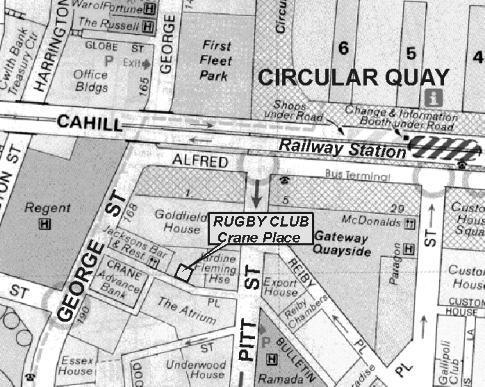
Rugby Club Location Map - Click to Enlarge
The Tanami Region: Expanding the Potential for Gold
David Huston and the North Australian Project team from Geoscience Australia
Rugby Club - 5:30 p.m. Thursday, 29th April 2004.
The Tanami region, which straddles the border between the Northern Territory and Western Australia, has become Australia's premier Palaeoproterozoic gold province, with virtually all discoveries made since the mid-1980s. At present, the region has global resources totalling in excess of 350 tonnes, including the world-class Callie deposit, which has a global resource of over 210 tonnes and is open at depth. Over three-quarters of these resources are hosted by sedimentary rocks, including carbonaceous siltstone and banded-iron formation, with the rest hosted by basalt and dolerite.
In 2000, Geoscience Australia joined the Northern Territory Geological Survey in the North Australia Project under the National Geoscience Agreement to enhance the mineral prospectivity of the central Northern Territory. One of the principal aims of this program was to provide a geological synthesis of the Tanami region, with Geoscience Australia providing specialist services including geochronology, potential field modelling and mineral systems studies.
Our geochronology studies, which are partly supported by the NTGS, indicate that, with the exception of small ~2500 Ma inliers, deposition of sediments and granitoid intrusion post-dated the Barramundi Orogeny. The mainly turbiditic Tanami Group, which hosts most ore, was deposited between 1840 and 1835 Ma, terminated by the Tanami Event, the first major deformation event. Sediments and volcanics of the Ware Group and the Mount Charles Formation were deposited between 1825-1815 Ma and 1800-1790 Ma, respectively. The period between 1825 and 1790 Ma was also characterised by several periods of deformation and syntectonic granitoid intrusion. These rocks are overlain by younger rocks of the Pargee Sandstone and the Birrindudu Group. Our results also indicate that correlatives of the Tanami Group extend into the northern Arunta province to the south.
40Ar-39Ar studies of vein-hosted biotite from the Callie deposit are consistent with a ~1730 Ma age of mineralisation. However, geological relationships in The Granites Goldfield are not consistent with this timing, suggesting a possibility of multiple mineralising events in the region.
Forward modelling of potential field data has highlighted the 3-D geometry of structures and rock bodies in the Tanami region. These models have been used to constrain the fundamental architecture of the region and examine relationships between mineral deposits and this architecture.
Mineral system studies have determined that fertile fluids in the Tanami region were gaseous (CO2- and/or CH4-rich) with variable salinities, typical of lode gold ore fluids in many provinces. Studies of regional veins in the Tanami and Arunta regions have identified areas characterised by these fluids, including areas within the greenfields Arunta. Gold deposition occurs either due to decarbonising reactions in deposits hosted by carbonaceous sediments or sulphidation reactions in deposits hosted by BIF or mafic rocks. The size of the deposit is enhanced by the coincidence of a pre-exisiting anticlinal trap site, a well developed syn-mineralisation structural corridor, and, possibly, zone refining.
Our studies in the Tanami region will be extended for a period of up to two years, with emphasis given to: (1) acquisition and interpretation of land seismic data; (2) acquisition of additional geochronology data to better constrain the age of certain units and the age of mineralisation; and (3) sequence stratigraphic studies to understand the shape of the Tanami Group basin and identify the location of chemically reactive rocks within that basin.
Biography of David Huston
After gaining B.Sc. and M.Sc. degrees from Colorado School of Mines and the University of Arizona, David crossed the Pacific, completing a PhD and a series of postdocs at the University of Tasmania on VHMS and iron-oxide Cu-Au deposits in Tasmania, Queensland and the Northern Territory. He then returned to North America with a stint at the Geological Survey of Canada, where he worked on the giant Kidd Creek VHMS deposit and VHMS deposits in Manitoba. He crossed the Pacific again to take up a job at AGSO (now Geoscience Australia) documenting the metallogeny of the Pilbara. Over the last four years he has led GA's North Australia Project, a joint NGA project with the Northern Territory Geological Survey. This project has provided fundamental geological, geophysical, geochronological, architecture and metallogenic information for the Tanami and Arunta regions.

Rugby Club Location Map - Click to Enlarge
The Feedjit SMEDG Visitor Map
Which one of the red squares is you?